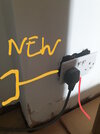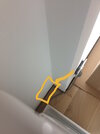Hi,
I have this socket (see the pictures) that I've got a washer and a dryer plugged into, but I'm going to put some cupboards there so the socket won't be accessible anymore.
I want to either move this socket to the left or add another socket there, whichever is easier, as I won't be using the existing socket due to its inaccessibility.


I thought that since there will be a washer (~10Amp), a dryer (~4Amp heat pump) and Ikea lights (<1Amp) plugged into that new triple socket, then maybe it's worth keeping it on the ring, what do you think?
As I understand if I keep it on the ring then I'll need two junction boxes, but I'm not sure if I'll be able to fit two of them within that backbox. Would it be fine to just connect everything with a bunch of wagos or each extension has to be additionally concealed in its own box? In this scenario I guess I'd have to cover everything with a blank plate as well.
Alternatively, I can add a spur socket which might be easier to do as long as its fine for this load since there wouldn't be any connectors/junction boxes involved. Is this a better option?
Regarding the new socket location, I'm going to have it surface mounted as the plaster is crap on that wall and it's going to sit inside the cupboard anyway, so I don't care about the appearance. I was going to just drill through the corner and have all the wires going through the sides of the backboxes. Do I have to keep the grey PVC where the wires run through the wall or given the short distance (~20cm) the sheathing is not required? It might be a bit easier to bend the wires without it.
Finally, what sort of testing I should carry out once I've done all this and does this type of work have to be certified?
Thanks
I have this socket (see the pictures) that I've got a washer and a dryer plugged into, but I'm going to put some cupboards there so the socket won't be accessible anymore.
I want to either move this socket to the left or add another socket there, whichever is easier, as I won't be using the existing socket due to its inaccessibility.


I thought that since there will be a washer (~10Amp), a dryer (~4Amp heat pump) and Ikea lights (<1Amp) plugged into that new triple socket, then maybe it's worth keeping it on the ring, what do you think?
As I understand if I keep it on the ring then I'll need two junction boxes, but I'm not sure if I'll be able to fit two of them within that backbox. Would it be fine to just connect everything with a bunch of wagos or each extension has to be additionally concealed in its own box? In this scenario I guess I'd have to cover everything with a blank plate as well.
Alternatively, I can add a spur socket which might be easier to do as long as its fine for this load since there wouldn't be any connectors/junction boxes involved. Is this a better option?
Regarding the new socket location, I'm going to have it surface mounted as the plaster is crap on that wall and it's going to sit inside the cupboard anyway, so I don't care about the appearance. I was going to just drill through the corner and have all the wires going through the sides of the backboxes. Do I have to keep the grey PVC where the wires run through the wall or given the short distance (~20cm) the sheathing is not required? It might be a bit easier to bend the wires without it.
Finally, what sort of testing I should carry out once I've done all this and does this type of work have to be certified?
Thanks

